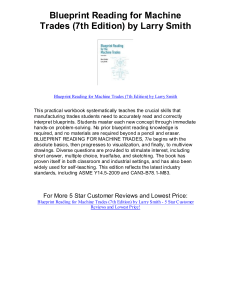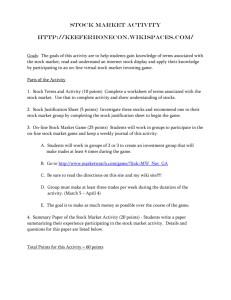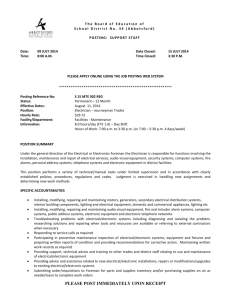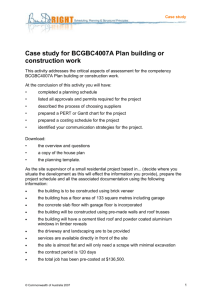The Asymmetry of the Price Impact of Block Trades and the Bid
advertisement
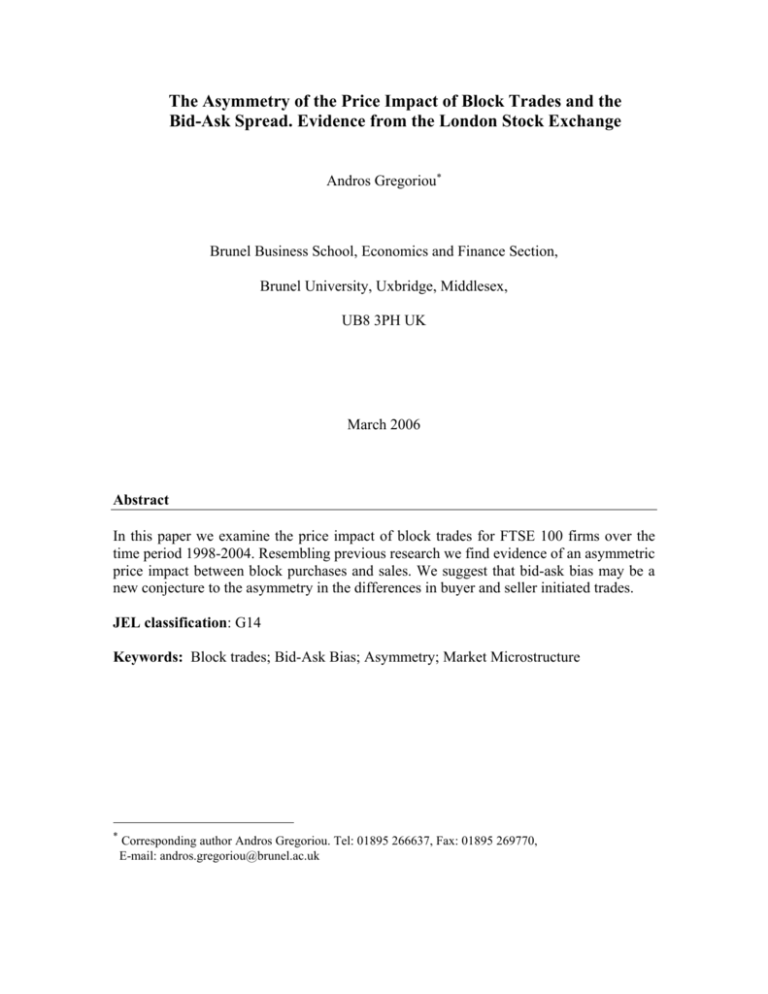
The Asymmetry of the Price Impact of Block Trades and the Bid-Ask Spread. Evidence from the London Stock Exchange Andros Gregoriou∗ Brunel Business School, Economics and Finance Section, Brunel University, Uxbridge, Middlesex, UB8 3PH UK March 2006 Abstract In this paper we examine the price impact of block trades for FTSE 100 firms over the time period 1998-2004. Resembling previous research we find evidence of an asymmetric price impact between block purchases and sales. We suggest that bid-ask bias may be a new conjecture to the asymmetry in the differences in buyer and seller initiated trades. JEL classification: G14 Keywords: Block trades; Bid-Ask Bias; Asymmetry; Market Microstructure ∗ Corresponding author Andros Gregoriou. Tel: 01895 266637, Fax: 01895 269770, E-mail: andros.gregoriou@brunel.ac.uk 1. Introduction In 2004, over 50% of total FTSE 100 trading volume was executed in blocks of 10,000 shares or greater; in 1984 block trades represented just 5% of total FTSE 100 trading volume. Given the significant increase in trading volume, block trading has received immense attention in the financial markets literature. The interest stems from the practical implications of such research, including investigations of the markets available to execute block trades and the roles they serve (see among others Keim and Madhaven, 1996 and Madhaven and Cheng, 1997); the association between blockholder ownership and market liquidity (Heflin and Shaw, 2000); and the determinants of the trading costs of block trades (see among others Keim and Madhaven, 1997 and Conrad et al, 2001). The behaviour and measurement of the price impacts connected with block trades is of fundamental importance to policy makers promoting market liquidity, and portfolio manager’s investment strategies. The components of investment strategy include the selection of blocks to buy or sell. Trading costs can substantially reduce the return on an investment. Consequently, there is considerable interest in assessing the magnitude of trading costs. There are two major components to trading costs: explicit costs consisting mainly of commission costs, and implicit costs, consisting primarily of the price impact of a trade.1 Explicit costs are very difficult to minimise because they are typically charged at predetermined rates. Implicit costs on the other hand, can be minimised. Schwartz and Shapiro (1992) argue that institutional investors, who normally trade in 1 There are additional transactions costs, such as taxes, clearance and settlement fees. These are ignored because they are too small to have an impact on trading volume (Keim and Madhaven, 1997). 1 large quantities, are concerned with the opportunity costs involved in undertaking these large trades. Gemmill (1996) discovers an asymmetry in the price effects of buyer and seller initiated trades on the London Stock Exchange (LSE). The asymmetry indicates that block sellers pay a liquidity premium while buyers do not, as price reversals accompany block sales while price continuations follow block purchases. The block trading literature measures price impact using transaction prices. This implicitly assumes an equal probability of a trade at the bid or ask. If this is not the case, block trade price effects will be systematically biased. There is significant evidence that prices at the open and close of trade on the NYSE have a tendency to occur at the ask (Harris, 1989 and Porter, 1992).2 This implies that returns measured using prices near the close will be upwardly biased. The asymmetry in the price behaviour of returns following block and institutional trades is consistent with such biases. Frino et al (2003) analyze price effects of block trades for the 30 stocks that comprise the Dow Jones Industrial Average over the time period of 1993-2001. They discover that excluding block trade price effects of bid-ask bias eliminates the systematic differences between block purchases and sales. 2 Aitken et al (1995) document similar evidence for the ASX. 2 Motivated by the discussions above, this paper re-examines the price impact of block trades for FTSE 100 firms over the time period 1998-2004, in order to determine the cause of the asymmetry between block purchases and sales. Our study contributes in several respects to the work of Gemmill (1996). First, we examine the asymmetry between block purchases and block sales with respect to bid-ask bias. Second, our sample of block trades covers a time period of 7 years (1998-2004). This dataset is very large when compared with the dataset used by Gemmill (1996). This is reflected by the fact that Gemmill (1996) examines 3010 block purchases and 2977 block sales whereas; our dataset consists of 1.6 million block purchases and 1.2 million block sales. The rest of the paper is organized as follows. Section 2 describes the data and methodology used to implement the econometric analysis. Section 3 documents and replicates the asymmetry between block purchases and block sales found in Gemmill (1996). A bid-ask spread explanation for the asymmetry between block purchases and sales can be found in Section 4. The empirical results and robustness tests are provided in Sections 5 and 6. Finally Section 7 concludes. 2. Data and Methodology This study focuses on block trades in the FTSE 100 over the time period January 1, 1998 to January 1, 2004. These block trades are of particular interest as they account for a substantial fraction (around 70%) of total LSE volume and market capitalisation. Block trades are defined by the LSE as trades of 10,000 shares or greater. The data used in this 3 study were obtained from the LSE database. Several filters are applied to the trades and quotes.3 Trades are designated as being seller or buyer initiated using the trade direction algorithm developed by Ellis et al (2000), which states that if a trade occurs at the ask quote the trade reflects a purchase and if the trade is executed at the bid price then the trade is classified as seller initiated. Transactions which execute at neither the bid or ask price are classified using the tick test, such that if the last price change was an uptick the trade is buyer initiated, and vice versa for sales. Table 1 provides the descriptive statistics for the block trades analysed in this study. The overall sample consists of 1,613,766 block purchases, and 1,226,599 block sales. At first inspection, Table 1 reveals some common features of both seller and buyer initiated block trades. As mentioned previously, sample transactions are very large compared to Gemmill (1996); for the whole sample the typical block trade involves an average in excess of 1 million shares. Our sample of block trades is slightly dominated by buyerinitiated blocks, and that seems to be the case for stocks with larger market capitalisation. Gemmill (1996) and Frino et al (2003) have pointed out the asymmetry of buy and sell blocks, with the latter being more frequent then purchased blocks. [INSERT TABLE 1 HERE] 3 Trades are omitted if they are indicated in the LSE database to be coded out of time sequence. Trades indicated to be exchange acquisitions or distributions, or that involve nonstandard settlement are also omitted, as are trades that are not preceded by a valid same-day quote. Quotes are omitted if either the ask or bid price is non-positive. 4 Following previous literature (see among others Gemmill (1996), Keim and Madhaven (1996) and Madhavan and Cheng (1997)) block trade price effects are measured as follows: P Temporary Effect = log b Pc (1) P Permanent Effect = log c Pp (2) P Total Effect = log b Pp (3) Where Pp is the equilibrium market price prior to the block transaction, while Pc is the equilibrium price after a block trade has been executed4. Pb represents the block price. Price effects measured using transaction prices, substitute the open and closing price for Pp and Pc respectively. This methodology attempts to capture the price effects of block trades and any information leakage as shown by Keim and Madhavan (1996) and Madhavan and Cheng (1997). 3. Price Impact Asymmetry Table 2 summarises the price impact of block purchases and sales. Consistent with Gemmill (1996), there appears to be a significant asymmetry in the price impact of buyer and seller initiated trades. Reversals predicted by short run liquidity costs follow sales and consistent with the information hypothesis, total price effects suggest block sales 4 Pp and Pc are calculated with the use of a 20 day event window. This measure allows for a delay in the market’s speed of adjustment to the block trade. 5 move the price of a stock on average by –23.16 basis points. Block purchases on the other hand have a total price effect of 32.66 basis points. This demonstrates that like Gemmill (1996) we observe a clear asymmetry in the price behaviour of block trades on the LSE. [INSERT TABLE 2 HERE] 4. A Bid-Ask Spread Explanation A possible explanation for the asymmetric price behaviour between block purchases and sales could be trading cost biases in transaction data. Gemmill (1996) measures the price impact of block trades with the use of transaction prices. This implicitly assumes an equal probability of a trade occurring at the ask or at the bid price. If this is not the case, block trade price effects will be systematically biased. There is significant evidence that prices at the open and close of trade have a tendency to occur at the ask (Harris, 1989, Porter, 1992 and Aitken et al, 1995). In order to explore whether the asymmetry between block buys and block sells is due to the tendency to trade at the ask price, we test for the impact of bid-ask bias by computing returns which are purged of bid-ask effects. The propensity to trade at the quotes is examined by documenting the frequency of trades at the bid and the ask price. The frequency of trades occurring at the ask and at the bid price are computed with the use of the order flow ratio. The order flow ratio is calculated for the open and closing price on block trading days, as follows: Order Flow Ratio = ( ask − price ) ( ask − bid ) (4) 6 As the order flow ratio approaches 1 the more likely the trade price is at the bid price, while the closer the ratio is to zero the greater the likelihood the trade is at the ask (Lease et al, 1991). The implementation of quote returns as suggested by Lease et al (1991) will diminish the effects of systematic order flow imbalances biasing transaction prices. To eliminate transaction returns of bid-ask bounce quote return measures are devised. Engle and Patton (2000) discover an asymmetry in the impact of buyer or seller initiated transactions on market quotes. They argue that purchases exhibit a greater impact on the ask side of the market, while the bid price leads the ask price following sales. In order to incorporate this, seller initiated block trade price effects are calculated using bid prices, while block purchase price effects are examined with the use of ask quotes. Quote effects, identified as bid-trade-bid/ask-trade-ask replace Pp in equations 2 and 3 with the opening bid/ask quote and Pc in equations 1 and 2 with the closing bid/ask price, while maintaining Pb as the block trade price, in order to ascertain how much of the asymmetry is due to bid-ask bias in open and closing prices. 5. Empirical Results 5.1 Propensity to Trade at the Ask Quotes Table 3 evaluates the percentage of opening and closing transactions at the ask quote on block trading days for the largest 100 stocks on the LSE. Clearly there is a tendency for both the opening and closing prices to be at the ask. Consistent with Porter (1992) and Frino et al (2003) we find a significant difference between the relative 7 frequencies that trade commences and ceases at the bid and ask quotes. On block trading days, 30 percent of closing prices are at the ask quote, while only 26 percent are at the bid price, a similar story is depicted for the opening price with 15.23 percent of trades at the ask and only 10.23 percent at the bid. Tests of equal proportions of trades occurring at the bid and the ask price based on chi-square tests show a significant difference for both the opening and closing price. The mean order flow ratio also supports contentions that the opening and closing transactions have a propensity to execute at the ask price. [INSERT TABLE 3 HERE] 5.2 Price Impacts of Block Trades Purged of Bid-Ask Bias The significance of the propensity for the open and closing price to be at the ask quotes is measured by changes in price effects using bid and ask quotes. Mean returns purged of bid-ask bias in table 4 portray a different impression of a block trade then those provided in table 2. Turning firstly to ask-trade-ask returns, purchases are associated with a significant total price effect of 16.63 basis points. Analogous to the continuation following purchase, block sales are associated with a total price decline of 11.03 basis points. Table 4 implies that bid-ask bias is a possible explanation for the directional asymmetry in return between buyer and seller initiated block trades. [INSERT TABLE 4 HERE] 5.3 Price Impacts of Matched Block Trades An advantage of matching techniques is that no functional form is imposed to control for differences in transactions. This is of particular interest to block trade price effects in the LSE as Gemmill (1996) discovers a non-linear relationship between trade size and price revisions. Block purchase and sales are as closely matched as possible. Matches have 8 been selected on a minute by minute and week by week sequential search before and after the block trade such that pairs are not selected on the same day and do not exceed a oneyear event window (Choe et al, 1995 and Frino et al, 2003).5 An issue that arises with matching is whether pairs are selected with or without replacement. Sampling with replacement results in two independent samples, unlike samples selected without replacement, where the extent of covariance between samples depends on population size. If the population is very large the covariance is close to zero, such that the sampling with or without replacement is almost identical. Given the large number of possible matches available, pairs are selected with replacement.6 Once trades were matched the dataset consisted of 924,344 block buys and sells. The matched trades are relatively smaller then the unmatched trades, reflecting on the impact of the strict matching procedure. We witness from table 5 that the results obtained from table 4 are strongly reflected in the analysis on matched block trades. The asymmetry of the price impacts associated with buyer and seller initiated trades is significantly reduced once the bid-ask bias has been eliminated. This demonstrates the effect of controlling for the market environment and systematic differences between block purchases and sales. [INSERT TABLE 5 HERE] 5 If block purchases and sales were matched on the same day differences between permanent price effects would be downwardly biased, falsely accepting tests of equality between buy and sell information effects. 6 We also conducted the analysis using sampling without replacement. The results (not reported) are almost identical to the results with replacement. 9 6. Robustness Tests Several robustness tests are carried out to examine the persistence of the results from the previous sections. Firstly, results are analysed across block trade sizes, Secondly, results are computed on year-by-year basis. Separating block trades into categories of 10,000 to 20,000, 20,000 to 50,000 and greater than 50,000, following Madhavan and Cheng (1997), the asymmetry documented in table 2 for trade price effects is observed consistently. Once quote returns are substituted for transaction prices, the asymmetric price response between purchases and sales is eliminated. Across the seven years examined, the asymmetry is observed for five years, and insignificant in 2000 and 2001. This reinforces our contention that it is the propensity to trade at the ask during the open and close of trade on the LSE that results in an anomaly in the empirical block trading literature. 7. Conclusion Gemmill (1996) established that an asymmetry exists in the price behaviour surrounding buyer and seller initiated trades on the LSE. However, the biases introduced through the existence of the bid-ask spread were ignored in his study. In this paper we observe that, estimating block price effects using quote returns to eliminate bid-ask bounce in transaction price returns, produces symmetrical behaviour in price effects surrounding block trades. A significant positive price reaction followed by a continuation is reported for purchases, and a significant negative price reaction followed by a permanent price fall for sales. The results are robust across trade sizes and trading 10 years. Our empirical results suggest market liquidity is one of the factors that is driving the asymmetry between block purchases and sales in the LSE. 11 References Aitken, M., Brown,P., Izan,H., Kua,A., and T.Walter, (1995), An intraday analysis of the probability of trading on the ASX at the asking price, Australian Journal of Management, Vol. 20(2), pp. 115-154. Choe, H, McInish, T.H, and R.A. Wood, (1995), Block verses non-block trading patterns, Review of Quantitative Finance and Accounting, Vol 5, pp 355-363. Conrad, J.S., Johnson, K.M. and S.Wahal, (2001), Institutional trading and soft dollars, Journal of Finance, Vol. 61, pp. 397-416. Ellis, K., Michaely, R., and M. O’Hara, (2000), The Accuracy of Trade Classification Rules: Evidence from NASDAQ, Journal of Financial and Quantitative Analysis, Vol. 35, pp. 529-552. Engle, R.F., and A.J. Patton, (2000), Impacts of trades in an error-correction model of quote prices, Unpublished working paper, University of California, San Diego, pp. 1-40. Frino, A, V. Mollica, and T. Walter (2003), Asymmetric price behaviour surrounding block trades: A market microstructure explanation, Unpublished Working Paper, Centre for Analytical Finance. Gemmill, G., (1996), Transparency and Liquidity: A Study of Block Trades in the London Stock Exchange under Different Publication Rules, Journal of Finance, Vol. 51, pp.1765-1790. Harris, L. (1989), A day-end transaction price anomaly, Journal of Financial and Quantitative Analysis, Vol. 24, pp. 29-45. Heflin, F, and K.W. Shaw (2000), Blockholder Ownership and Market Liquidity, Journal of Financial and Quantitative Analysis, Vol. 35, pp. 621-633. 12 Keim, D.B., and A.Madhavan, (1996), The upstairs market for large-block transactions: Analysis and measurement of price effects, Review of Financial Studies, Vol. 9, pp. 1-36. Lease, R., Masulis,R., and J.Page, (1991), An Investigation of Market Microstructure Impacts on Event Study Returns, Journal of Finance, Vol. 46(4), pp. 1523-1536. Madhavan, A., and M.Cheng, (1997) In search of liquidity: Block trades in the upstairs and downstairs markets, Review of Financial Studies, Vol. 10, pp. 175-204. Schwartz, R. & J.Shapiro, (1992) The challenge of institutionalisation for the equity markets. In: Saunders, A. (Ed) Recent Developments in Finance, New York University Centre, New York, NY. 13 TABLE 1 Summary Statistics of Block Purchases and Sales for the FTSE 100 over the time period January 1998 to January 2004. Table 1 reports the number of observations, the mean, median, minimum, maximum and standard deviation for block trade size. The sample consists of all LSE trades in the largest 100 companies stocks of 10,000 or more shares for the period January 1, 1998 to January 1, 2004. Block Buys Block Sells Number of Mean observations 1,613,766 22,125 1,226,599 21,579 Descriptive Statistics Median Minimum 16,000 16,000 10,000 10,000 Maximum Standard deviation 10,300,000 18,900.44 9,520,000 21,876.33 14 TABLE 2 Transaction Price Effects of Block Trades Table 2 reports transaction returns surrounding block trades of 10,000 shares or more executed on the 100 largest stocks on the LSE for the time period January 1, 1998 to January 1, 2004, broken down by buyer (Panel A) and seller (Panel B) initiated trades. Three measures of price impact are reported: (1) Temporary, defined as the logarithmic return from the block price to the block price after the execution of a block trade; (2) Permanent, defined as the logarithmic return from the block price after the execution of a block trade to the equilibrium price prior to the block transaction; and (3) Total, defined as the logarithmic return from the block price to the equilibrium price prior to the block transaction. Panel A Buys (n = 1,613,766) Mean Standard Deviation t-statistic Temporary 3.56 157.63 17.72* Trade Returns Permanent 31.62 224.76 29.43* Total 32.66 182.79 46.32* Temporary -1.04 145.31 -8.23* Trade Returns Permanent -26.72 222.85 -99.37* Total -23.16 186.89 -94.87* Panel B Sells (n= 1,226,599) Mean Standard Deviation t-statistic * Significant at the 95% level 15 TABLE 3 Prices Relative to Bids and Asks on Block Trading Days Table 3 reports the distribution of opening and closing prices at the quotes on block trading days. Panel A provides the relative frequencies across the two categories of trade position relative to quotes in addition to order flow ratios. Panel B provides chi-square tests of equality for the position of opening and closing transaction across the two categories (Equality across all categories); across the cumulative frequency of trades being close to the bid or ask, given by the sum of relative frequencies at the bid and the ask price. Panel A Distribution of Open and Closing Prices Trade At Ask At Bid Open Close Mean Order Flow Ratio 15.23 10.23 29.76 26.12 0.4575 0.4876 Panel B Tests of Percentages of Prices by Bid-Ask Position Open Price Close Price Equality at bid and ask Equality at bid and ask χ2 =603* χ2 = 102* * Significant at the 95% level 16 TABLE 4 Quote Price Effects of Block Trades Table 4 reports mean returns purged of bid-ask bias surrounding block trades of 10,000 shares or more executed on the 100 largest stocks on the LSE for the time period January 1, 1998 to January 1, 2004, broken down by buyer (Panel A) and seller (Panel B) initiated trades. Three measures of price impact are reported: (1) Temporary, defined as the logarithmic return from the block price to the block price after the execution of a block trade; (2) Permanent, defined as the logarithmic return from the block price after the execution of a block trade to the equilibrium price prior to the block transaction; and (3) Total, defined as the logarithmic return from the block price to the equilibrium price prior to the block transaction. Panel A Buys (n = 1,613,766) Mean Standard Deviation t-statistic Temporary 12.23 154.49 99.59* Ask-Trade-Ask Returns Permanent 23.26 216.93 119.72* Total 16.63 187.63 48.86* Temporary Bid-Trade-Bid Returns Permanent Total -10.74 149.15 -72.84* -27.37 179.12 -102.45* -11.03 167.96 -45.29* Panel B Sells (n= 1,226,599) Mean Standard Deviation t-statistic * Significant at the 95% level 17 TABLE 5 Quote Price Effects of Matched Block Trades Table 5 reports transaction returns surrounding block trades of 10,000 shares or more executed on the 100 largest stocks on the LSE for the period January 1, 1998 to January 1, 2004, broken down by buyer (Panel A) and seller (Panel B) initiated trades, based on matching purchases with replacement to sales on size, stock, time of day and weekday. Three measures of price impact are reported: (1) Temporary, defined as the logarithmic return from the block price to the block price after the execution of a block trade; (2) Permanent, defined as the logarithmic return from the block price after the execution of a block trade to the equilibrium price prior to the block transaction; and (3) Total, defined as the logarithmic return from the block price to the equilibrium price prior to the block transaction. Panel A Buys (n = 924,344) Mean Standard Deviation t-statistic Temporary 11.63 149.51 -96.32* Ask-Trade-Ask Returns Permanent 21.19 204.17 102.16* Total 10.96 177.23 65.32* Temporary Bid-Trade-Bid Returns Permanent Total -10.74 132.13 -69.81* -21.94 182.32 -102.49* -9.21 169.84 -69.45* Panel B Sells (n= 924,344) Mean Standard Deviation t-statistic * Significant at the 95% level 18

